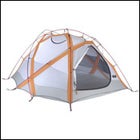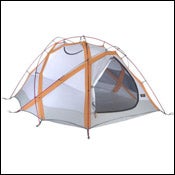Tents really dont differ all that much in basic materials, whether its a light summer camping tent or a beefy expedition tent. Mainly, the tents for really serious environments add poles for strength, space for extra gear (winter sleeping bags, for instance), and vestibules for cooking and boot-donning.
 The Trango 2
The Trango 2Take s Trango 2 ($550). It has five poles to help it shed wind and snow, two doors for easy access, a big vestibule, and 41 square feet of floor space (most backpacking two-person tents have 35 or less). Its designed for really tough conditions and would do well on notoriously windy Aconcagua.
But that doesnt really differ much from a tent marketed as for “four seasons,” such as Stretch Dome 3 ($549). It also has five poles, uses the same material weight in the body (70-denier fabric), and has a big vestibule. Its a little larger47 square feetas it is a three-person tent. But it is, for all intents and purposes, an expedition tent.
So if you have a good-quality four-season tent, you should be fine. Make sure it has not been in the sun a lot as that could lead to weakened fabric. And take plenty of guy-out material and small nylon sacks to fill with snow and bury as line anchors. Youll need them.
Have a great trip!


